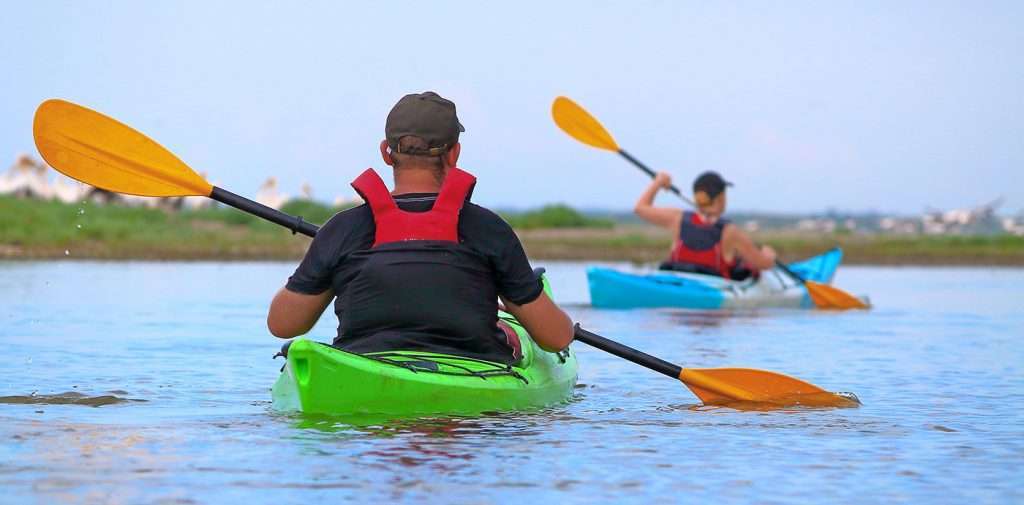In theory, paddling is simple. There are only three types of strokes: propelling, turning and bracing. But just these three strokes can seem daunting considering the multitude of variations and stroke combinations. At the most advanced level, just a simple flex of the wrist can alter the direction of travel and angle of the boat.
Paddle
First the paddle. In a canoe, choose the side you want to paddle on. This is your on-side. Your hand on this side of the boat is your shaft hand and holds the shaft of the paddle. Your other hand is your grip hand, which rests on top the paddle’s grip and controls the angle of the blade. Your hands should be spaced comfortably about shoulder width apart and your arms should remain mostly straight. If you paddle with a tandem partner, you will need to have opposite on-sides.
Kayakers should first hold the paddle horizontal above and resting on your head. Slide your hands apart so that your elbows bend at right angles. Lower the paddle in front of you and make sure your hands are equal distance from each blade.
There are a few basic principles for achieving maximum efficiency from your paddle strokes. For maximum power transfer, angle the blade perpendicular to the force of resistance. When you want the boat to move forward, hold the paddle vertically. As you apply power through the stroke, ensure that the blade of the paddle remains vertical to the water’s surface. Any alteration to the lateral and vertical angles will create a turning motion or create lift out of the water – both are wasted energy if you are trying to go straight. A second principle is to face your work and apply power from your major muscle groups.
You’ll have much more strength and endurance in your back and shoulders then in just your arms. Rather than simply pulling on the paddle with your arms, rotate your torso and unwind through the stroke. Rotating your torso so that your chest faces your paddles also protects from possible shoulder injuries. This principle is easily applied by watching the blade throughout each stroke. As you gain experience, you’ll be able to rotate your body while looking in any direction.
Strokes
The basic strokes are pretty simple. To turn left, take a wide-reaching sweep stroke on the right. For a forward stroke, keep your paddle close in and parallel to the boat’s centerline. To move sideways, place the paddle out to the side and draw yourself into it. You can perform each of these strokes on both sides and in reverse.
Capsize
Even if you become an expert paddler, you may eventually capsize (swim or flip). If you’re in a canoe, just fall out. Your PFD will keep you afloat. Do your best to hold onto your boat and paddle. If you’re on moving water, float on your back with your feet on the surface of the water. In even a shallow river with a current, your feet can become trapped under a rock. While holding your boat and paddle with one hand, swim with your other hand to the nearest shore or eddy. Try not to stand up until you are out of the current.
Self-rescue
If you capsize in a kayak, you need a little more patience. Gravity will get you out, but you need to keep your legs straight. As soon as you flip over, tuck forward and pull on the spray deck grap loop, which should be right in front of you. Slide your hands on the deck behind you and push out while doing an upside-down somersault. Wait until your feet are completely out of the kayak before coming to the surface. The whole process takes only a few seconds, but it’s worth practicing a few times to reduce any anxiety about being turned upside-down under water. Try to grab your boat and paddle before they float away. On calm, flat water, your partner may be able to help you drain and reenter your boat without swimming to shore.
Paddling takes practice, but even the novice can enjoy learning this exciting pastime. A few simple lessons from a qualified instructor will speed up your learning process dramatically and help you explore new paddling adventures. Before you know it, you’ll be on your way to paddling adventure.

